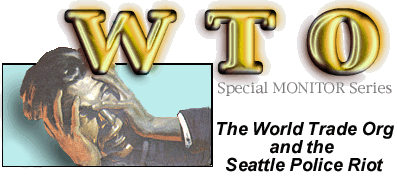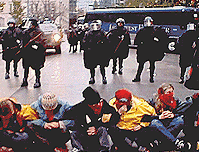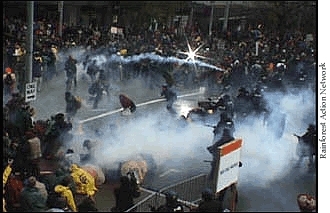
Seattle '99, Chicago '68
by Jeff Elliott
 |
by Jeff Elliott |
|
 Just
before the start of the WTO summit, Seattle Deputy Police Chief Ed Joiner was sanguine about the upcoming demonstrations. Not to worry, he boasted -- the cops were ready. They had an understanding with protesters; civil disobedience would be treated with respect, and they would "peacefully arrest" peaceful demonstrators. "We're going to kill them with kindness," Joiner said.
Just
before the start of the WTO summit, Seattle Deputy Police Chief Ed Joiner was sanguine about the upcoming demonstrations. Not to worry, he boasted -- the cops were ready. They had an understanding with protesters; civil disobedience would be treated with respect, and they would "peacefully arrest" peaceful demonstrators. "We're going to kill them with kindness," Joiner said.
A few days later, it looked like Seattle police had decided to kill them by more direct means, such as clubbing. Police attacked peaceful demonstrators in the worst police riot in the United States in more than thirty years. Not since the 1968 Chicago Democratic Party Convention have cops engaged in such thuggery. How did this come to happen? Certainly you saw the pictures: Big street protests, broken store windows, swirling tear gas clouds -- all of those appeared in the mainstream media. But also like Chicago '68, coverage was scattershot. The whole world wasn't watching because the television networks offered no live coverage. Newspaper reporting was better, but enormous gaps were left; few reporters seemed prepared to find themselves in a war zone. As a result, Joanna Q. Public is forgiven if she believes that it was simply a story of rioting protesters. Yet a closer examination shows that there's no question that it was the police who abruptly changed tactics and attacked. Nor was it the case of few rogue cops; law enforcement groups acted in concert, breaking all promises made to honor nonviolent civil disobedience. The only questions that remain is whether they intended violence from the beginning, and whether they used agent provocateurs in the crowd to justify their abuse of power.
|
|
The Battle
of Seattle begins at 9:54AM on November 30, when the police donned gas masks at the intersection of Sixth Avenue and Union Street. The crowd fell silent long enough to cover their own faces with scarves or bandannas, pitifully inadequate protections against the choking tear gas.

At the time the intersection was jammed with peaceful demonstrators still celebrating their recent victories. Before 8 o'clock that morning, a coalition of labor, enviro, and human rights groups had linked arms at the city's Convention Center to block WTO delegates from entering. Some were moved to tears by the emotion of the moment; they knew this had become one of the most memorable protests in American history. Now a few minutes before ten, the black-clad riot police had blocked escape to the east and west at the 6th and Union intersection, where hundreds stood or danced or weaved to the sound of drummers. When the police pulled on the masks, the drummers fell silent. "They're getting ready," someone shouted. As an officer gave the order to disperse through a bullhorn. "Sit down and stay sitting. We will not be provoked," a young woman protester countered. Like a wave, almost everyone settled to the pavement. Right at 10AM (by a report from the Tacoma News Tribune), the assault began, as pepper spray rained in a "thick stream." Tear gas canisters were launched; an officer fired rubber bullets into the crowd. Many endured the three-prong attack for several minutes, but it wasn't long before most of the crowd fled, gagging and their eyes streaming. According to independent reporter Janet Berkow, one man refused to budge, lying face-down on the pavement. She quotes a protester who witnessed the event: "'They must have shot about 40 bullets at him, right into him, trying to make him move.' He shook his head, saying, 'It made me want to cry. They looked just like Nazi storm troopers. They didn't say a word --- they just started shooting.'"
|
|
Despite
the chaos after the police attack at 6th and Union, the crowd remained filled with bonhomie. Many headed up Sixth, exhilarated. Those on one side of the street shouted, "we love you!" The other side echoed, "we love you too!" It was still a street party, albeit one where most had runny noses and teary eyes.
It was an hour later when the first sightings are reported of the "Black Bloc," a motley group of anarchists also protesting the WTO conference. (Their name means only that they're a "bloc" of people with the same interests rallied underneath the traditional black anarchist's flag.) Then around 11AM, demonstrators gathered near at 4th and Union glimpsed a curious thing: about 40 men clad entirely in black moving south on Fourth Ave. in formation. Not that they were marching in step, exactly; just that they seemed to have a... purpose, according to eyewitnesses. Another eyewitness a short distance away reports seeing "a group of about 50 plus" starting their rampage of violence at about this time, darting out of alleyways to break windows and vandalize, then regroup. But so few people saw this clique that most eyewitness and media reports peg the violence as starting midafternoon. The demonstrators had reason to be distracted. Police were methodically attacking protester lockdowns in several intersections and near the big hotels, using the same heavy-handed tactics -- boxing in a group and then peppering the crowed with gas and rubber bullets. More and more people were being treated for injuries caused in skirmishes with police. Most common were flushing eyes with water to counteract pepper and tear gas, but there were more serious harm that deserved hospital care. Some were struck directly in the head and face with the rubber bullets and tear gas grenades fired at point-blank range. Although Seattle police chief Norm Stamper told the press that day they weren't prepared for such a big protest, it seems that they certainly prepared to fight the unarmed demonstrators.
|
|
As
Seattle's finest were mercilessly attacking protesters just a few blocks away, police chief Stamper said the most remarkable thing at a press conference: They simply weren't ready. "They said it would be the biggest protest of the century, and they were right." His department had simply failed to do adequate "threat
analysis" and should have had up to four times the 1,200 officers on the street.
It was either an admission of gross incompetence or an astonishing lie. [Editor's note: Stamper resigned on Monday.] They knew that the 1997 WTO meeting in Geneva was the scene of angry protests; they certainly knew that 50-100,000 protesters were coming; they knew that some protest groups had been preparing for months. And they even knew many of the protest leaders personally. For weeks, law enforcement had been meeting with the Direct Action Network, a coalition of the many groups planning to march and engage in peaceful protest. Just the night before, some of the leaders met for the last time with police representatives. The demonstration groups wanted to have a classic protest arrest: The police would order them not to cross a line, and the protesters would step over it en masse and then wait peacefully to be arrested. The police refused, saying that they didn't have the manpower to make mass arrests. Han Shan, the WTO coordinator for the Ruckus Society, saw this as an astonishing betrayal. "I'd stood at a press conference with [Seattle mayor Paul] Schell on one side and [Deputy Chief] Ed Joiner on the other," recalls Shan. "We explained exactly how we were planning to shut down the conference. We made all our plans in public." So detailed were these discussions that publicity terms had even been decided. "The police told us they would actually wait until the cameras were rolling to film arrests to allow for the choreography of the confrontation to unfold in a dramatic way," Mike Dolan, deputy director of Global Trade Watch told the Seattle Times. "We sat in the City Council chambers and at the Labor Temple and they told us, 'We've done this so many times' and regaled us with stories of peaceful arrests and easy street actions."
|
|
But
while police were making soothing sounds to demonstration leaders, they were preparing for war. For 18 months, all police agencies in the area had been training in crowd control at the state's police academy, the Tacoma newspaper found. In their arsenal were waiting the latest in sub-lethal weapons:
Nor did the cops use these toys sparingly. By midafternoon, they had exhausted the department's estimated $20,000 stockpile of tear gas and pepper spray, according to the Seattle Post-Intelligencer newspaper. Emergency supplies were aquired from the state prison system and smaller police departments, and the new ammo was carted to the front lines in duffel bags carried by undercover officers. |
|
 Given
the police reaction on Tuesday, it's worth noting that only about 25 people were taken into custody; protesters were ready for 1,000 peaceful arrests, at least. Even more surprising: Not among those arrested were any of the "anarchists" responsible for the vandalism.
Given
the police reaction on Tuesday, it's worth noting that only about 25 people were taken into custody; protesters were ready for 1,000 peaceful arrests, at least. Even more surprising: Not among those arrested were any of the "anarchists" responsible for the vandalism.
Where were the police? Many protesters reported seeing a masked man in black trying to incite the crowd to riot or loot stores, to no avail. After the AFL/CIO march in midafternoon, the black-clad vandals destroyed windows in block after block. "We called 911 from inside our store, asking for help, telling them that people were rampaging in the streets, but they said they were too busy," storekeeper Maryann Swissa told The New York Times. Photojournalists certainly had no trouble finding the troublemakers. Pictures went across the newswires showing windows being shattered by newsstand racks or a hefty kick. A masked "anarchist" was followed up the street by a clutch of TV cameras documenting his carnage at leisure. Adding a dose of irony, the protesters ended up defending stores owned by the very transnationals they were protesting. "Here we are protecting Nike, McDonald's, the Gap and all the while I'm thinking, 'Where are the police? These anarchists should have been arrested,'" Global Exchange spokesperson Medea Benjamin also told The Times. The police excuse that they didn't have the manpower doesn't wash, particularly considering there were forces only a few blocks away busily suppressing peaceful protests. And Shan of the Ruckus Society was among those who also witnessed a curious thing: when protesters detained an anarchist and called for the cops, officers refused to make the arrest. There are only two possible interpretations of events: Either Seattle authorities willfully ignored the destruction of up to $9 million in property because they gave a higher priority to harassment of peaceful protesters -- or just maybe, they were in cahoots with some of the men in black.
|
|
Certainly
there was a loose association of anarchists there anxious to make a "statement" by trashing storefronts owned by the worst transnational villains; no one disputes that. But while they boast of their damage done, they won't take credit for inciting the police to violence. In a press communique, one group included this item as part of a
list of misconceptions:
Myth: "They escalated situations on the 30th, leading to the tear-gassing of passive, non-violent protesters." To answer this, we need only note that tear-gassing, pepper-spraying and the shooting of rubber bullets all began before the black blocs (as far as we know) started engaging in property destruction... What can be learned of the sequence of events bears them out; the prominent vandalism took place late afternoon. Then what was going on, here? Who were members of the well-organized crew spotted that morning, dashing in and out of alleys to vandalize? Why did police refuse to answer calls for help, or even arrest men in black that were held for them? It's not so fantastic to wonder if some of the black bloc were other plainclothes members of law enforcement. Consider: Police knew well the games anarchists play, some of whom came from an infamous group in nearby Oregon that had caused destruction there in June. The Seattle police talked about the anarchists with representatives from Direct Action Network, and knew that window-smashing was a certainty. Also, police knew that these tactics were anthema to the peaceful protesters. As long as a man in black wasn't tackled by a cop, he could move without challenge, a dark spectre drifting through crowded streets invisible. Nor would there have to be an overarching conspiracy involving the 1,200 rank+file cops. Interviewed on local television, officers said they were told to strictly not break formation; "crowd control" was their foremost task (even though that crowd was well under control, thank you). If any of the covert anarchists were really federal law enforcement, few -- if any -- of the Seattle police had to know. For the FBI, such an assignment would have been a cakewalk. Accustomed to having agents infiltrate organizations, it would be simple for agents to play anarchist by wearing the appropriate black grunge. Such a disguise would give them the opportunity to gather intelligence -- and just maybe, if they were lucky, incite some of the peaceful protesters to riot. The anarchists would have been a dream scapegoat. And it was federal authorities that had a motive to welcome anarchist disruption. Show the world 70,000 united demonstrators from all walks of life and you discredit the WTO; broadcast pictures of even one rioter and you invalidate the protester's message. Violence trumps peaceful discourse easily on the evening news. |
|
 It will
take months, probably years, to distill the truth of what really happened those days. This article only touches on some of the incidents on November 30 and none of the events the next night, when police made a senseless assault on the residential Capitol Hill neighborhood.
It will
take months, probably years, to distill the truth of what really happened those days. This article only touches on some of the incidents on November 30 and none of the events the next night, when police made a senseless assault on the residential Capitol Hill neighborhood.
While it's apparent that Seattle authorities made the decision to attack peaceful demonstrators in advance, the key question to answer is why. Han Shan was one of the negotiatiors who felt that authorities simply didn't take the demonstration leaders seriously when they predicted up to 100,000 would converge on Seattle. "They didn't respect us enough to believe us," he says. But now a picture is also emerging of the role federal law enforcement agencies had in the police riot of Seattle, and it's not flattering. The FBI and Secret Service were deeply involved with planning, and emphasized that authorities anticipated violence. Members of the police department believed that they should expect losing 5 or 6 officers, either killed or seriously injured. Thus Seattle leaders were hearing radically different messages: In one ear were heard promises of peaceful civil disobedience. In the other ear were whispered threats of terrorism. Which side should they believe? Their actions show that they listened only to the federal side. It was a foolish mistake to make, but can almost be understood. Since 1996, the FBI and other agencies have insisted that "domestic terrorism" is a major threat, and D.C. has spent millions training local police and equipping them with anti- terrorist gear, as was showcased on the streets of Seattle. If that wasn't enough, the local press has mostly ignored the serious issues behind the WTO protests (see MONITOR item in this issue), yet printed inflammatory material, such as part of the four-part series on "eco-terrorism" produced by the the conservative Portland Oregonian newspaper. But no matter what really happened those days, it will be remembered forever the shame of Seattle, just like the events surrounding the 1968 Democratic Party convention are forever branded to Chicago. A description written by independent reporter Trevor Griffey could have easily appeared 31 years ago: As the day progressed, the police became increasingly belligerent. They got more liberal with every part of their violent arsenal, and by the end of the night, not only were they refusing to give their names and badge numbers, they were succumbing to violent and illegal acts worse than anything protesters did yesterday. They targeted protesters they didn't like for beatings. They doused passersby with pepper spray to retaliate for being flipped off. They shot at anyone who offered the slightest insult. In trying to restore peace, the police became the most violent and tyrannical presence in the city -- one that respected private property, but was hostile to all people.
Albion Monitor
December 6, 1999 (http://www.monitor.net/monitor) All Rights Reserved. Contact rights@monitor.net for permission to use in any format. |